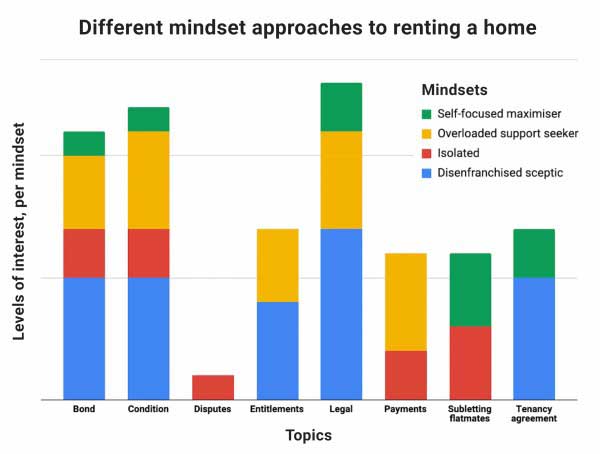In this blog post Leigh talks about how DIA are putting users at the centre as they set about designing an all-of-government information architecture.
We’re actively putting users at the centre as we set about designing an all-of-government information architecture.
Information architecture is about connecting users to the content they need. This means understanding and mapping the relationships between users, their triggers and the information and services they’re looking for.
The first step is really getting to grips with who needs government information and services, and why.
Building on research, not reinventing the wheel
We’re running a series of workshops to build on previous research, and to help government practitioners get into the headspace of people who are using their services. The workshops are designed to help us gather ‘triggers’ to understand why people interact with government.
The first thing we learned is that there is a lot of research going on in different agencies into user behaviours, their pain points, and journeys. We’re also becoming aware of the differences between research into very specific service requirements at the agency level, and broader all-of-government triggers.
Our discovery phase has led us back to some of the earlier research that was done in 2012 when the concepts of working together to deliver joined up services was first gaining traction.
We dusted off the all-of-government personas, which were backed by thorough research, and stripped them back to their core to see if the basic mindsets and triggers are still valid. We think they are, but we need to test that further. Meanwhile the ‘mindsets’ (or proto-personas) have given us a great starting point for thinking about our users’ triggers.
We’ve also started looking more closely at the work done in 2016 to come up with a set of life events. This was a convenient way to think about the many different services and bits of information a person might need when they ‘become bankrupt’ or ‘start tertiary study.’
Proto-persona workshops
Our first session in early March saw 25 people from various parts of Department of Internal Affairs coming together to talk about triggers, from different mindsets.
The main goal of these workshops is to generate a starting point for our vendor to take and continue this task.
We commissioned a piece of work to:
- validate and update a list of services that government provides
- help us visualise the complexity of a users’ current interactions with government.
Mapping the relationships between many triggers or entry points into one service, and what people need in that specific situation, will help us design our all-of-government IA.
It will also help us identify what is core information, and what needs to change according to the trigger. Understanding this is the key to delivering structured content where the core chunks are reusable.
Validation with users
We recognise that all this foundation work is inward focused, and not talking to users. But we want to leverage the collective knowledge held across government, and then validate our findings with real people, rather than start from scratch. That validation phase also comes later.
What we’ve learned so far
We gathered about 750 triggers across 8 mindsets, and about half of the 34 life events.
There is a lot of repetition, but some high-level theming has shown that the main things people are looking for (regardless of their triggers) are:
- information about services — things they need to know like costs and eligibility
- assistance and support — programs and generally ‘help’
- benefits — financial entitlements.
Beyond the top few topics, there were some trends that show how one mindset approaches their search, compared to others.
Mindsets
Four of the mindsets we identified are:
- self focused maximiser — looking to get the most from government, with few responsibilities beyond themselves
- overloaded support seeker — highly complex and continually changing circumstances
- isolated — severe isolation — social, cultural or geographic
- disenfranchised sceptic — poor previous experiences with the government leading to low expectations and a lack of trust.
As an example, the following graph shows how different mindsets are likely to be interested in different topics related to renting a home.
Topics relating to renting a home are displayed across the horizontal X axis.
The vertical Y axis is divided into sub groups to give an indication of which mindsets are interested in each topic.
The vertical bars shown for each topic are divided up into sub groups that represent different mindsets. The sub groups give an indication of which mindsets are interested in each topic.

Detailed description of the image
This vertical bar graph shows the breakdowns for one life event: renting a home. The graph illustrates how some topics or situations, for example bond, condition, disputes, entitlements, legal, payments, or tenancy agreement, will be more relevant to one type of mindset than another.
There are no specific figures; the graph shows trends and which are the most popular topics overall. For example, the ‘disenfranchised sceptic’ is more likely to be interested in topics related to bond, condition, entitlements, legal and tenancy agreement.
Slicing and dicing the data
The other thing we've done is look at ways of slicing and dicing the data. We’ve been investigating a new tool called Reframer. It’s part of the Optimal suite and allows you to capture observations out of user research sessions and tag and theme them relatively easily.
Building an all-of-government IA is part of the Navigate programme of work, commissioned by Government Information Services at the Department of Internal Affairs. The programme team are based at the Service Innovation Lab.
If you would like to receive updates from us, please contact navigate@dia.govt.nz


